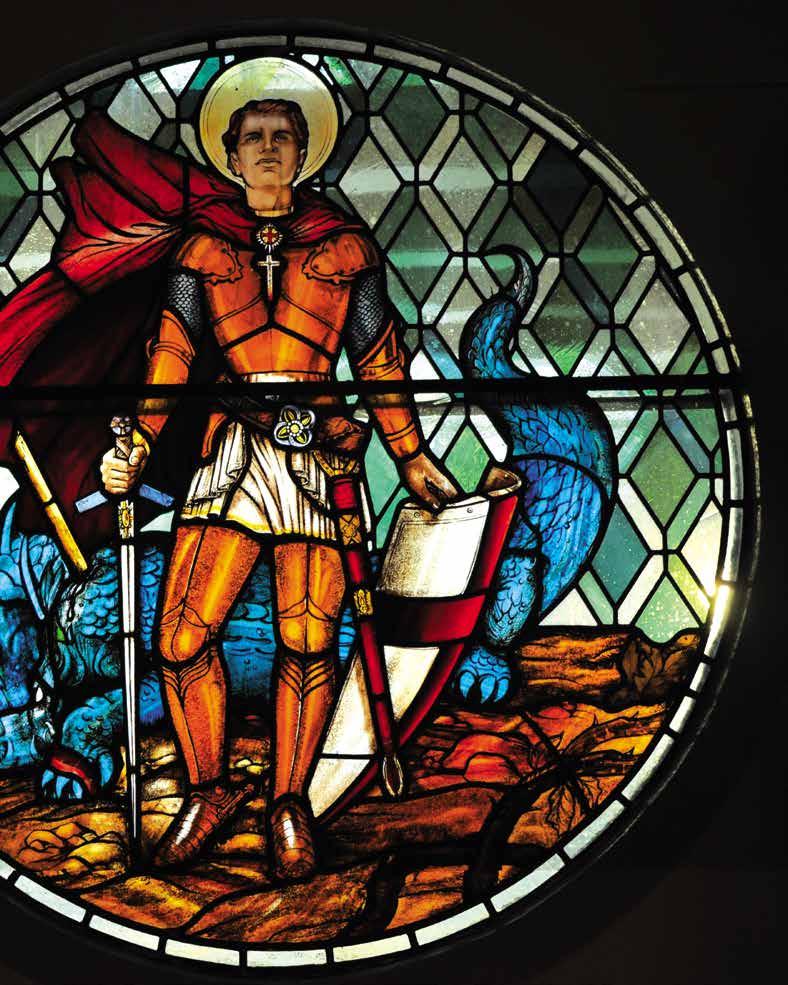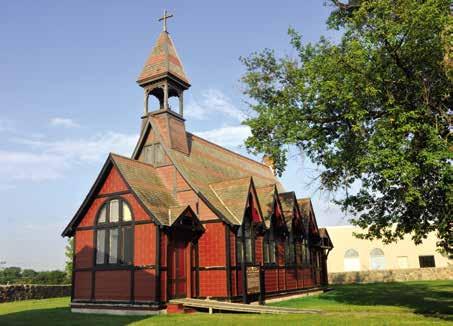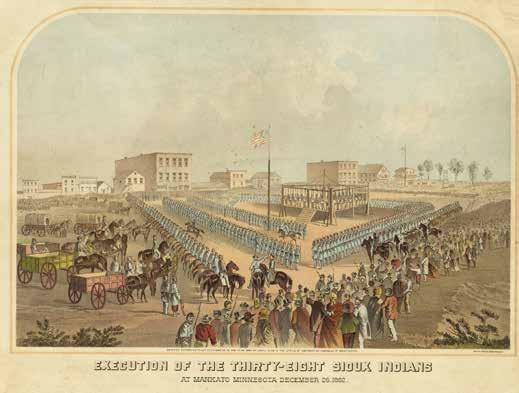
4 minute read
The History of St. George’s Episcopal Church
Cover Photo: St. George, photography by Dakota Goodhouse, North Dakota Humanities Council, 2012
By Amy Juhala, Associate Professor of English at Bismarck State College
Advertisement
The first Episcopal Church service in Bismarck was held in the Capitol Hotel on March 8, 1873, when James Humbert, infant son of Lt. and Mrs. Humbert of Camp Hancock, was baptized by the Rev. Charles Swift.
On July 4, 1876, the Far West riverboat docked in Bismarck after a ten-day continuous voyage downriver from the Little Bighorn, bearing news of General Custer’s defeat. The news was brought immediately to Camp Hancock where Bismarck’s only telegraph line carried the news to St. Paul, Chicago, and Washington, D.C. The news of a major military campaign’s utter defeat wrinkled the United States’ centennial celebration. After the message was sent, it was imperative to keep the wire open until further details could be gathered from the survivors aboard the Far West. Colonel Lounsberry, also the editor of the Bismarck Tribune and a correspondent of the New York Herald, reached into his pocket and pulled out the Episcopal Book of Common Prayer and set it on the operator’s desk with the instruction, “Send this!,” and he did.
Bishop Clarkson of Nebraska made a visit to Bismarck. In the fall of 1877, he appointed the Rev. J. A. Graham of Brainerd, Minnesota, to conduct services in Bismarck on the third Sunday of each month. The church service was held in the old city hall located on the east side of Fourth Street between Broadway and Thayer Avenues. The ladies of the congregation organized a New England dinner which earned them $200. This encouraged them to continue with the organization of the church.
In 1878 the Rev. Miller became the first resident missionary. Church services were conducted in a new brick schoolhouse, located where the Provident Life Insurance building now stands, and the Protestant Episcopal Church of Bismarck was organized.
At the request of Bishop Clarkson, the board of directors of the Northern Pacific Railroad deeded six lots to the church. These lots were located on the northeast corner of Mandan Street and Avenue A and cost a total of $30. The construction of a church building was completed by June 1881. Given the name The Church of the Bread of Life, the first Episcopal church of Bismarck was consecrated on Whitsunday by Bishop Clarkson, assisted by the Rev. Dr. Batterson of Philadelphia. The cost of the building was $2000 without furnishings.
In 1882, the bell from the ill-fated steamboat Red Cloud was given to the Bismarck Episcopal community by Captain I. P. Baker, which was mounted in the belfry under his supervision. The bell was given to the Red Cloud by a pioneer Nebraska community in honor of the Oglala Lakota chieftan Red Cloud. The steamboat burned on the Upper Missouri but the bell was salvaged by an insurance company and bought by Captain Baker for the new Bismarck Episcopal Church. The bell has called worshippers to service since.
In 1887, the church’s name was changed to St. George’s Episcopal Church. People thought the name, Bread of Life, suggested that the congregation was high church, an idea which they did not wish to promote. Around the turn of the century, the church building was moved to Third Street and Thayer Avenue. This old historic church building has been moved from that location to Camp Hancock, where it has been preserved and is now open to the public and used occasionally for special services.
In April 1938, a new church was discussed with Bishop Atwill and, in 1941, H. M. Leonhard, an architect and member, was invited by the vestry to develop plans and estimates for the new building. Construction was begun after the war. On September 10, 1949, the members of St. George’s parish attended the first services in the new church, now called St. George’s Episcopal Memorial Church. The church building is noted for its many memorials and especially the stained glass windows. They were made in Brighton, England, by the firm of Barton, Kinder, and Alderson. All of the blue/green-bordered windows contain (in the border) fragments of glass salvaged from churches in southeast England destroyed by enemy bombing raids during World War II. Some of this glass dates back to the twelfth century, and in the window borders, one may see a glass fragment of a hand, foot, or forehead that had once graced another church.
The church has remained essentially unchanged since its construction except for two improvements. St. George’s aging organ was replaced by a Moller pipe organ in 1986. To accommodate the new organ in the sanctuary, the altar was moved forward closer to the chancel steps.
The congregation welcomes you to St. George’s Episcopal Church.

Church of The Bread of Life, photograph by Dakota Goodhouse, North Dakota Humanities Council, 2012.







